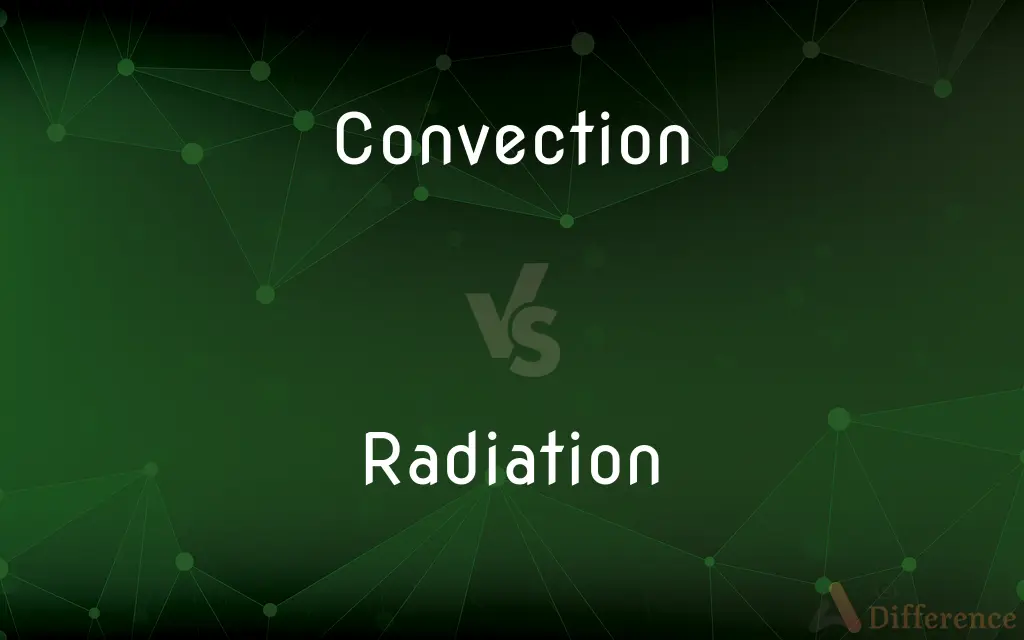Convection vs. Radiation — What's the Difference?
By Tayyaba Rehman — Updated on September 23, 2023
Convection is the transfer of heat through a fluid (liquid or gas) by the movement of the fluid itself. Radiation is the transfer of energy through electromagnetic waves, such as light, without the need for a medium.

Difference Between Convection and Radiation
Table of Contents
ADVERTISEMENT
Key Differences
Convection and Radiation are both mechanisms for the transfer of energy, but they operate in fundamentally different ways. Convection involves the movement of a fluid (liquid or gas) that carries heat with it, commonly seen in processes like boiling water or air currents. In contrast, radiation involves the transfer of energy via electromagnetic waves, such as visible light, microwaves, or infrared radiation, without requiring a medium to move through.
In the case of convection, the heated fluid rises due to reduced density, and the cooler fluid takes its place, thus forming a convective cycle that redistributes heat. This principle is behind many natural and industrial processes, like ocean currents or the heating systems in buildings. Radiation, on the other hand, can transfer energy across a vacuum, as seen with the Sun radiating energy to Earth.
Convection generally occurs in confined systems where a fluid can circulate, whether that's a pot of boiling water or the Earth's atmosphere. Radiation is universal; it can occur anywhere, including in a vacuum like outer space. For example, Earth receives radiant energy from the Sun despite the vacuum of space between them.
In summary, convection is heat transfer facilitated by the movement of a fluid, requiring a medium for this movement. Radiation is the transmission of energy via electromagnetic waves, capable of occurring without any medium. While both are forms of energy transfer, they are distinct in their requirements and the contexts in which they commonly occur.
Comparison Chart
Medium Required
Yes (fluid)
No
ADVERTISEMENT
Type of Energy
Thermal energy
Electromagnetic energy
Movement
Physical movement of medium
No movement of medium
Where it Occurs
Confined systems
Anywhere, including vacuum
Examples
Boiling water, air currents
Sunlight, microwaves
Compare with Definitions
Convection
Requires a medium (fluid) for energy transfer.
Convection cannot occur in a vacuum because it requires a medium.
Radiation
Transfer of energy through electromagnetic waves.
The Sun radiates energy through electromagnetic waves.
Convection
Heated fluid rises, and cooler fluid descends.
In convection, warm air rises while cooler air sinks.
Radiation
Can transfer heat as well as light.
Infrared radiation can transfer heat.
Convection
Heat transfer through fluid by the fluid's movement.
Boiling water demonstrates the principle of convection.
Radiation
Universal, occurring in varied contexts.
Radiation occurs naturally and artificially.
Convection
Common in natural and industrial processes.
Ocean currents are driven by thermal convection.
Radiation
In physics, radiation is the emission or transmission of energy in the form of waves or particles through space or through a material medium. This includes: electromagnetic radiation, such as radio waves, microwaves, infrared, visible light, ultraviolet, x-rays, and gamma radiation (γ) particle radiation, such as alpha radiation (α), beta radiation (β), proton radiation and neutron radiation (particles of non-zero rest energy) acoustic radiation, such as ultrasound, sound, and seismic waves (dependent on a physical transmission medium) gravitational radiation, radiation that takes the form of gravitational waves, or ripples in the curvature of spacetimeRadiation is often categorized as either ionizing or non-ionizing depending on the energy of the radiated particles.
Convection
Involves physical movement of the medium.
The circulation of air is an example of convection.
Radiation
The act or process of radiating
The radiation of heat and light from a fire.
Convection
Convection is single or multiphase fluid flow that occurs spontaneously due to the combined effects of material property heterogeneity and body forces on a fluid, most commonly density and gravity (see buoyancy). When the cause of the convection is unspecified, convection due to the effects of thermal expansion and buoyancy can be assumed.
Radiation
Emission or propagation of energy in the form of waves or particles.
Convection
The act or process of conveying; transmission.
Radiation
Energy radiated or transmitted in the form of waves or particles.
Convection
Heat transfer in a gas or liquid by the circulation of currents from one region to another.
Radiation
A stream of particles or electromagnetic waves emitted by the atoms and molecules of a radioactive substance as a result of nuclear decay.
Convection
Fluid motion caused by an external force such as gravity.
Radiation
The act of exposing or the condition of being exposed to such energy.
Convection
(Meteorology)The transfer of heat or other atmospheric properties by massive motion within the atmosphere, especially by such motion directed upward.
Radiation
The application of such energy, as in medical treatment.
Convection
(obsolete) The process of conveying something.
Radiation
(Anatomy) Radial arrangement of parts, as of a group of nerve fibers connecting different areas of the brain.
Convection
(physics) The transmission of heat in a fluid by the circulation of currents.
Radiation
Adaptive radiation
Convection
(meteorology) The vertical movement of heat and moisture, especially by updrafts and downdrafts in an unstable air mass. The terms convection and thunderstorm are often used interchangeably, although thunderstorms are only one form of convection. Towering cumulus clouds are visible forms of convection.
Radiation
The shooting forth of anything from a point or surface, like diverging rays of light.
Heat radiation
Convection
The act or process of conveying or transmitting.
Radiation
The process of radiating waves or particles.
Convection
A process of transfer or transmission, as of heat or electricity, by means of currents in liquids or gases, resulting from changes of temperature and other causes.
Liquids are generally heated by convection - when heat is applied from below.
Radiation
The transfer of energy via radiation.
Convection
The transfer of heat through a fluid (liquid or gas) caused by molecular motion
Radiation
Radioactive energy.
Convection
(meteorology) the vertical movement of heat or other properties by massive motion within the atmosphere
Radiation
A rapid diversification of an ancestral species into many new forms.
Radiation
The act of radiating, or the state of being radiated; emission and diffusion of rays of light; beamy brightness.
Radiation
The shooting forth of anything from a point or surface, like the diverging rays of light; as, the radiation of heat.
Radiation
Energy that is radiated or transmitted in the form of rays or waves or particles
Radiation
The act of spreading outward from a central source
Radiation
Syndrome resulting from exposure to ionizing radiation (e.g., exposure to radioactive chemicals or to nuclear explosions); low doses cause diarrhea and nausea and vomiting and sometimes loss of hair; greater exposure can cause sterility and cataracts and some forms of cancer and other diseases; severe exposure can cause death within hours;
He was suffering from radiation
Radiation
The spontaneous emission of a stream of particles or electromagnetic rays in nuclear decay
Radiation
The spread of a group of organisms into new habitats
Radiation
A radial arrangement of nerve fibers connecting different parts of the brain
Radiation
(medicine) the treatment of disease (especially cancer) by exposure to radiation from a radioactive substance
Radiation
Does not require a medium for energy transfer.
Radiation can occur in the vacuum of space.
Radiation
Can be hazardous in certain forms.
X-rays are a form of harmful radiation.
Common Curiosities
What is Radiation?
Radiation is the transfer of energy through electromagnetic waves.
Does Convection require a medium?
Yes, convection requires a fluid medium for heat transfer.
What is Convection?
Convection is the transfer of heat through a fluid by the movement of the fluid itself.
Where does Convection commonly occur?
Convection commonly occurs in confined systems like liquids and gases.
Where does Radiation commonly occur?
Radiation can occur anywhere, including in a vacuum.
Does Radiation require a medium?
No, radiation can occur without a medium, even in a vacuum.
How does Convection transfer energy?
Convection transfers energy through the physical movement of a heated fluid.
Is Radiation always harmful?
No, not all forms of radiation are harmful; for example, visible light is a form of radiation.
Can Convection occur in a vacuum?
No, convection cannot occur in a vacuum.
How does Radiation transfer energy?
Radiation transfers energy through electromagnetic waves.
Is Convection only thermal energy?
Convection primarily involves the transfer of thermal energy.
Is Convection involved in weather systems?
Yes, convection plays a significant role in weather patterns.
Can Radiation occur in a vacuum?
Yes, radiation can transfer energy in a vacuum.
What types of energy does Radiation transfer?
Radiation can transfer various forms of electromagnetic energy, including light and heat.
What are some examples of Convection?
Examples of convection include boiling water, air currents, and ocean currents.
Share Your Discovery

Previous Comparison
Calibration vs. Standardization
Next Comparison
Launch vs. SteamerAuthor Spotlight
Written by
Tayyaba RehmanTayyaba Rehman is a distinguished writer, currently serving as a primary contributor to askdifference.com. As a researcher in semantics and etymology, Tayyaba's passion for the complexity of languages and their distinctions has found a perfect home on the platform. Tayyaba delves into the intricacies of language, distinguishing between commonly confused words and phrases, thereby providing clarity for readers worldwide.
















































